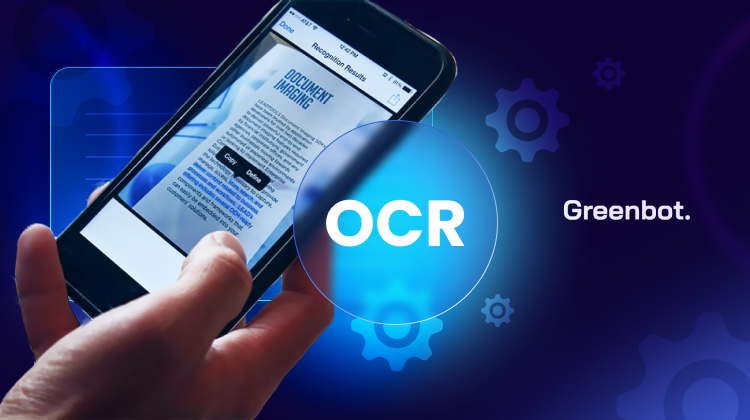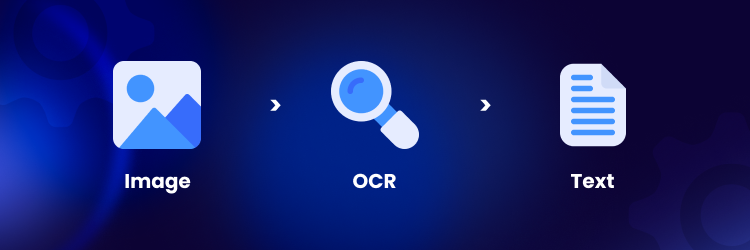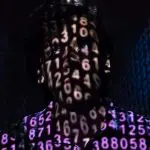
Optical Character Recognition (OCR) transforms printed, handwritten, or scanned text into digital formats. This OCR technology reads text from images and documents then converts it into searchable digital content. In short, the OCR means automating text recognition. It aims to make data more accessible and manageable.
Using OCR tools, scanned documents become digital assets, reducing manual data entry. This benefits many sectors, like healthcare and law, by simplifying data handling.
This article will explore OCR, its uses, and its productivity benefits.
What is OCR (Optical Character Recognition)?
Optical Character Recognition (OCR) converts printed or handwritten text into digital content. It reads characters from images or scanned documents then converts it into a searchable and editable format. By doing so, it eliminates the need for manual retyping and ensures data is easy to store and access. This process aligns closely with image to text technology, which allows users to extract text directly from photos or screenshots for various applications.
OCR tools automate data entry and simplify document management. They save time by quickly converting paper text into digital formats.
OCR technology is widely used in healthcare, finance, and office tasks. Through OCR systems and intelligent character recognition, physical text is made accessible digitally.
The History of Optical Character Recognition
OCR began in 1974 when Ray Kurzweil founded Kurzweil Computer Products, Inc. His early OCR technology could recognize printed text in almost any font. It was revolutionary. Kurzweil aimed to create a machine to help the vision-impaired by reading text aloud. This led to the creation of a text-to-speech reading device. In 1980, Xerox bought his company to develop OCR systems for converting paper documents.
In the early 1990s, OCR gained popularity for digitizing historical newspapers. Since then, OCR tools have advanced and now achieve near-perfect accuracy. In the past, documents had to be retyped, which was slow and prone to errors. Today, OCR is essential for efficient document management.
How OCR Technology Works
OCR technology has several steps. It converts images with text into digital, editable content. Key stages include image acquisition, preprocessing, text recognition, and postprocessing. Each step helps make scanned documents’ printed or handwritten text searchable and editable. Advances in AI Applications have significantly improved the efficiency and accuracy of OCR systems, enabling their use in diverse industries.
It starts with image acquisition. The system captures text from a document. Next, preprocessing prepares the image by enhancing clarity, adjusting lighting, and reducing noise. Text recognition algorithms, like pattern matching, detect and extract characters from the image.
Some advanced OCR systems also use machine learning to enhance this process. This lets them adapt to different fonts, handwriting, and layouts, improving accuracy.
Image Acquisition
The first step is image acquisition. OCR software captures the document or image. This step ensures the text is clear for further processing. It may involve scanning or taking a digital photo. A high-quality image is crucial here since it directly impacts OCR accuracy.
AI-powered tools increasingly integrate Natural Language Processing (NLP) capabilities into this step, ensuring that even complex language structures in images are accurately identified.
Preprocessing
In preprocessing, the system cleans up the image to make character detection easier. This may include reducing noise, adjusting contrast, and correcting skew in the image. These enhancements prepare the image for advanced recognition stages. Some systems also leverage language models (LLMs) technologies to contextualize textual data during preprocessing, improving overall results.
Text Recognition
The OCR system identifies and extracts characters from the image during text recognition. Pattern matching compares shapes with known characters. Feature recognition finds each character’s unique traits. Advanced systems also use machine learning and intelligent character recognition (ICR). These tools help adapt to various fonts and writing styles, which boosts accuracy.
Layout Recognition
Layout recognition detects the document’s structure, such as columns, headings, and text blocks. This step keeps the original format. It allows editing or searching without losing the layout.
Postprocessing
Postprocessing improves the recognized text by fixing errors. It uses dictionary checks and predictive algorithms. This step also checks for any formatting inconsistencies. These refinements ensure the final output is both accurate and easy to read.
Types of OCR Technologies
OCR technology includes various types. Each has unique capabilities to meet different needs. Here are some key types:
| Type | Description |
| Simple OCR | Basic OCR technology that recognizes printed text and converts it into editable digital content. |
| Optical Mark Recognition (OMR) | Recognizes marks, such as checkboxes or bubbles, typically used in forms or tests. |
| Intelligent Character Recognition (ICR) | An advanced form of OCR that can recognize handwritten characters, adapting to different handwriting styles. |
| Intelligent Word Recognition (IWR) | Recognizes entire words instead of individual characters, useful for scanned documents with cursive handwriting or stylized fonts. |
Optical Character Recognition (OCR) vs. Intelligent Character Recognition (ICR)
OCR and ICR convert physical text into digital formats but have distinct OCR capabilities. OCR systems mainly handle printed text. So, they are best for standard documents with uniform fonts.
In contrast, ICR can read handwritten text and adapt to different styles. This adaptability is possible because ICR uses machine learning to recognize diverse handwriting and fonts more accurately.
Advanced OCR Techniques
Modern OCR technology uses advanced methods for text recognition. It is for complex or challenging situations. Here are some critical advanced methods:
- Zonal OCR. This technique lets OCR target specific areas (zones) in a document for text extraction. It’s commonly used in forms or invoices. Only certain sections, like names or dates, need recognition.
- Magnetic Ink Character Recognition (MICR). MICR is often used in banking to read characters printed with magnetic ink, such as those on checks. This advanced form of OCR is highly accurate, even in low-quality scanned documents.
- 3D OCR. Unlike traditional OCR, which focuses on flat surfaces, 3D OCR can read text on curved or uneven ones. It’s beneficial in industries where text is found on products or packaging.
- Computer Vision-Enhanced OCR. By incorporating computer vision, OCR systems can analyze layout, reading order, and visuals. This enhancement improves OCR’s ability to handle documents with complex structures. It can even convert visual elements like charts or diagrams into data.
- Generative AI-Driven OCR. Some OCR tools now use generative AI to organize and structure data faster. This advanced approach enables OCR systems to handle tough documents. These have irregular fonts, low resolution, and poor lighting.
Real-Time OCR Applications
Real-time OCR technology is widely used, providing instant text recognition in various scenarios. Here are five key areas where OCR systems operate in real time:
- Mobile Translation Apps. Real-time OCR tools in translation apps recognize text from images or scanned documents. They instantly translate foreign text using a smartphone camera. This helps users understand different languages.
- Traffic Sign Recognition: In smart vehicles, OCR capabilities detect and interpret traffic signs. This enhances driver safety and supports autonomous driving by providing real-time sign information.
- Augmented Reality (AR). AR applications use OCR technologies to overlay text on real-world objects. For example, they can translate foreign signs or store extra product information.
- Banking and Payment Processing. Mobile banking apps instantly scan checks and bills using OCR. This makes depositing funds or paying bills quick and easy without manual data entry.
- Retail and Inventory Management. In retail, OCR systems scan barcodes and labels in real time. This streamlines inventory tracking and enhances customers’ shopping experiences.
Common OCR Tools and Software
Today’s OCR tools offer a variety of features to suit different needs. They range from basic text recognition to advanced solutions. The latter uses intelligent character recognition to handle complex documents. Selecting the right OCR technology depends on your specific needs. Various options cater to personal and business use.
Options include open-source tools and paid solutions, each with unique strengths. This flexibility lets users find tools that fit their tasks, budget, and tech needs. OCR systems are beneficial for converting scanned documents into searchable, editable formats. Advanced OCR capabilities allow these tools to manage complex layouts, fonts, and languages.
Popular OCR Tools for Individuals and Businesses
- Adobe Acrobat. Known for its PDF capabilities, Adobe Acrobat also offers robust OCR features. It converts scanned documents into searchable, editable text. This makes it ideal for efficiently handling PDF files.
- ABBYY FineReader. ABBYY provides high accuracy and supports many languages. Its advanced OCR features make it popular for business use. It retains layouts and can batch process large volumes.
- Tesseract. Google’s open-source OCR engine is a flexible tool for developers. It’s free and highly customizable, but it needs some setup hence ideal for technical users.
- Microsoft OneNote. OneNote has basic OCR. It enables users to extract text from images and handwritten notes. It’s a great option for personal use and organizing notes and documents.
- Readiris: This OCR software supports various output formats, such as Word and Excel. It converts documents into editable formats. It also supports languages and compresses files.
Open-Source vs. Paid OCR Software
| Feature | Open-Source (e.g., Tesseract) | Paid Tools (e.g., Adobe Acrobat, ABBYY FineReader) |
| Cost | Free | Requires a subscription or one-time payment |
| Ease of Use | Basic, requires technical setup | User-friendly interface with support |
| Customization | Basic | High, ideal for developers |
| Accuracy | Good, but depends on the configuration | High, especially for complex documents |
| Support | Community support | Dedicated customer support |
Choosing the Right OCR Tool for Your Needs
- Volume of Documents. For high-volume scanning, consider tools with batch processing features, like ABBYY FineReader.
- Accuracy Requirements. Use tools like Adobe Acrobat or ABBYY for high accuracy. They are best for complex fonts and layouts.
- Integration Needs. Look for tools that integrate with your existing software. For example, Microsoft OneNote works well within the Office suite.
- Budget Constraints. Open-source options like Tesseract are good and cheap for basic needs. They’re practical and customizable.
Benefits of Using OCR Technology
OCR technology offers a range of advantages that make it valuable across industries. OCR converts scanned documents into digital formats, simplifying data management. This process makes information more accessible and easier to organize. If you’re dealing with physical files or large volumes of text, OCR tools reduce manual tasks and improve data accuracy.
OCR systems provide several benefits for businesses and individuals. They improve workflow efficiency and help reduce operational costs. With advanced OCR capabilities like intelligent character recognition, these tools can handle complex layouts and fonts, making them even more versatile.
Improved Data Accuracy
OCR reduces manual errors by automating data entry. Instead of manually typing out text from physical documents, OCR captures information accurately from scanned documents. This process minimizes human error and increases the reliability of data.
Enhanced Productivity and Efficiency
Using OCR boosts productivity by automating text input processes. With OCR tools, employees can quickly convert paper documents into digital files, freeing up time for other tasks. This efficiency enables businesses to handle more work in less time.
Cost Savings
OCR minimizes costs by reducing the need for paper usage and manual labor. By digitizing documents, businesses save on storage space and cut down on physical resources. This leads to long-term savings in both material and labor expenses.
Applications of OCR Technology
OCR technology has applications across various sectors. It helps make data more accessible and manageable. OCR tools simplify previously manual and time-consuming tasks by converting scanned documents into digital text. This technology is valuable for libraries, archives, and business operations. OCR capabilities streamline workflows and boost efficiency in many areas.
In today’s digital world, quick and accurate information processing is essential. OCR systems support automated document handling in areas like data entry, document retrieval, and accessibility enhancements. Here are some key areas where OCR technology proves invaluable.
OCR in Document Digitization
OCR technology enables libraries, archives, and businesses to digitize documents. Libraries and archives use OCR to turn printed books and articles into digital files. This digitization preserves rare texts, making them accessible to a broader online audience.
OCR tools simplify record management. They create searchable, editable copies of physical records. Companies can store digital contracts, reports, and invoices, reducing the need for physical storage. This approach saves space and enables quick document retrieval and sharing, streamlining operations.
OCR in Business Automation
OCR technology is essential in business automation, especially for data entry and processing. OCR systems allow companies to automate data entry tasks, reducing manual errors and saving time. For example, OCR can scan and input invoice data, speeding up financial processing.
In customer service, OCR assists by scanning and sorting incoming documents or forms. This automation ensures that data is accurately recorded and readily available for customer support. Overall, OCR capabilities enhance business operations, making data handling faster and more efficient.
OCR for Accessibility
OCR technology also promotes accessibility, helping visually impaired individuals access and interpret text. Here’s how OCR aids accessibility:
- Converts printed text into digital formats compatible with screen readers.
- Supports text-to-speech applications that read out digital content.
- It makes documents searchable, allowing users to find specific information quickly.
- Expands access to a variety of digital documents for learning and daily tasks.
Limitations of OCR Technology
While OCR technology provides many benefits, its limitations can affect its effectiveness. Challenges like low-quality documents, uncommon fonts, or sensitive data handling impact the accuracy and reliability of OCR systems. Knowing these limitations helps users make informed decisions when selecting OCR tools.
Even advanced OCR tools face difficulties in specific scenarios. Major limitations include text recognition accuracy, language compatibility, and data security.
Challenges in Text Recognition Accuracy
OCR struggles with poor-quality or handwritten documents. Low-resolution scans, faded ink, or smudged text can confuse systems, leading to errors that require manual correction. Handwriting presents additional challenges due to varying styles and legibility, even with modern ICR technology.
Language and Font Limitations
Uncommon fonts, decorative text, or languages with unique characters often confuse OCR systems, reducing accuracy. Many tools lack robust multilingual support, which affects performance in diverse settings.
Security and Privacy Concerns
OCR use in handling sensitive data, such as financial or medical records, raises security risks. Cloud-based solutions may expose data to breaches if not secure. Additionally, some apps store extracted data, creating privacy concerns if mishandled. Compliance with data protection regulations is critical when processing sensitive information.
FAQs About OCR Technology
What is the difference between OCR and ICR?
OCR (Optical Character Recognition) primarily recognizes printed text in standard fonts. However, ICR (Intelligent Character Recognition) is an advanced form of OCR. It can recognize handwritten text and adapt to different handwriting styles.
Can OCR read handwritten text?
Yes, but with limitations. Standard optical word recognition struggles with handwriting. ICR, which uses machine learning, is better at handling handwritten documents.
Is OCR a form of AI?
OCR itself is not a form of AI. However, modern OCR systems often incorporate AI and machine learning to improve accuracy. This is especially helpful for recognizing complex fonts and printed documents.
Is OCR 100% accurate?
No, OCR is not 100% accurate. It struggles with poor images, complex fonts, and handwriting. However, accuracy improves with high-quality image files and advanced OCR tools.
What are common OCR use cases?
OCR digitizes scanned legal documents, automates data entry, and processes invoices. It also supports document processing workflows in the healthcare, finance, and education sectors.
How secure is OCR technology?
OCR technology is generally secure, but data privacy depends on how the data is handled. Cloud-based OCR tools may pose risks if security protocols are not followed carefully.
Is OCR an NLP?
OCR and NLP (Natural Language Processing) are different technologies. OCR is about optical word recognition. It converts images of text into digital text. NLP processes the meaning of text.
Does OCR support multiple languages?
Yes, many OCR tools support multiple languages, including those with unique characters. However, language support varies across different tools.
How to OCR a PDF?
Use OCR software with PDF support, like Adobe Acrobat or ABBYY FineReader, to OCR a PDF. Upload the PDF; the software will convert it into searchable and editable text.
Optical Character Recognition: Conclusion
OCR technology has changed how we manage text in images and scanned documents. By converting these sources into digital formats, OCR advances digital accessibility and automation.
OCR’s capabilities include handwriting recognition and enhancing document workflows across industries. This technology makes data management easier. Users can edit, search, and organize information more efficiently.
Exploring OCR tools is worthwhile for anyone seeking to improve data workflows. Many OCR options can meet specific needs, from personal to professional use. Popular tools include Adobe Acrobat and ABBYY FineReader.
These tools offer reliable solutions for processing image files and other text documents. With OCR’s evolving capabilities, streamlining tasks has become simpler than ever. This technology also helps increase productivity in daily applications.



















